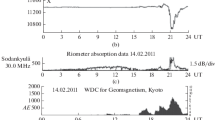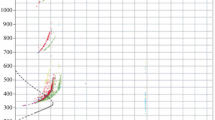Abstract—
The article analyzes the errors in estimating the parameters of the main ionospheric maximum, plasma frequency foF2 and its height hmF2, by automated systems for processing the vertical radio sounding data of the ionosphere at the IZMIRAN station in 2018, during a period of low solar activity. It considers the results of the two most commonly used programs that scale observatory registrations of the ionosphere state, ARTIST 5, part of the DPS-4 ionosonde (DPS–ARTIST complex), and Autoscala 5.1, adapted for the Parus-A ionosonde (Parus–Autoscala complex). An independent system for analyzing ionograms from the Parus-A ionosonde by an operator is used as an etalon in comparing the results. It is shown that the foF2 estimates by both automated systems are sufficiently reliable with a standard deviation of 0.1 MHz. The errors in hmF2 estimation differ significantly and are characterized by a general negative bias, depending on the year’s season, and are most significantly expressed in the local noontime. The statistical values of the hmF2 deviations, in the common case, are significantly larger for the DPS–ARTIST system and are principally close to the results of the comparison with the Millstone Hill incoherent scatter radar data.








Similar content being viewed by others
REFERENCES
Altadill, D., Magdaleno, S., Torta, J.M., and Blanch, E., Global empirical models of the density peak height and of the equivalent scale height for quiet conditions, Adv. Space Res., 2013, vol. 52, pp. 1756–1769. https://doi.org/10.1016/j.asr.2012.11.018
Bilitza, D., Sheikh, N.M., and Eyfrig, R., A global model for the height of the F2-peak using M3000 values from CCIR, Telecommun. J., 1979, vol. 46, pp. 549–553.
Bilitza, D., Altadill, D., Truhlik, V., Shubin, V., Galkin, I., Reinisch, B., and Huang, X., International Reference Ionosphere 2016: From ionospheric climate to real-time weather predictions, Space Weather, 2017, vol. 15, pp. 418–429. https://doi.org/10.1002/2016SW00159
Chen, C.F., Reinisch, B.W., Scali, J.L., et al., The accuracy of ionogram-derived N(h) profiles, Adv. Space Res., 1994, vol. 14, no. 12, pp. 43–46.
Davies, K., Radio Waves in the Ionosphere, Waltham, MA: Blaisdell, 1969; Moscow: Mir, 1973.
Galkin, I.A., Khmyrov, G.M., Kozlov, A.V., Reinisch, B.W., Huang, X., and Paznukhov, V.V., The ARTIST 5, AIP Conf. Proc., 2008, vol. 974, no. 1, pp. 150–159. https://doi.org/10.1063/1.2885024
Givishvili, G.V. and Leshchenko, L.N., Network ionosonde PARUS-A: Record history, in Sistemnyi monitoring ionosfery (System Monitoring of the Ionosphere), Moscow: Fizmatlit, 2019, pp. 21–37 (in Russian).
Krasheninnikov, I.V., Pavlova, N.M., and Sitnov, Yu.S., IRI model in the problem of predicting ionospheric radio-wave propagation under conditions of high solar activity, Geomagn. Aeron. (Engl. Transl.), 2017, vol. 57, no. 6, pp. 719–726.
Krasheninnikov, I., Pezzopane, M., and Scotto, C., Application of Autoscala to ionograms recorded by the AIS-Parus ionosonde, Comput. Geosci., 2010, vol. 36, pp. 628–635.
Panchenko, V.A., Ten years of the DPS-4 ionosonde in IZMIRAN, in Sistemnyi monitoring ionosfery (System Monitoring of the Ionosphere), Moscow: Fizmatlit, 2019, pp. 38–64 (In Russian).
Perrone, L., Mikhailov, A.V., Scotto, C., and Sabbagh, D., Testing of the method retrieving a consistent set of aeronomic parameters with millstone Hill ISR noontime hmF2 observations, IEEE Geosci. Remote Sens., 2020. https://doi.org/10.1109/LGRS.2020.3007362
Pezzopane, M. and Scotto, C., Software for the automatic scaling of critical frequency foF2 and MUF(3000)F2 from ionograms applied at the ionospheric observatory of Gibilmanna, Ann. Geophys., 2004, vol. 47, no. 6, pp. 1783–1790.
Pezzopane, M. and Scotto, C., Automatic scaling of critical frequency foF2 and MUF(3000)F2: A comparison between Autoscala and ARTIST 4.5 on Rome data, Radio Sci., 2007, vol. 42, RS4003. https://doi.org/10.1029/2006RS003581
Pezzopane, M. and Scotto, C., A method for automatic scaling of F1 critical frequency from ionograms, Radio Sci., 2008, vol. 43, RS2S91. https://doi.org/10.1029/2007RS003723
Pezzopane, M., Scotto, C., Tomasik, Ł., and Krasheninnikov, I., Autoscala: An aid for different ionosondes, Acta Geophys., 2010, vol. 58, pp. 513–526.
Reinisch, B.W. and Huang, X., Automatic calculation of electron density profiles from digital ionograms. Processing of bottomside ionograms, Radio Sci., 1983, vol. 18, pp. 477–492.
Scotto, C., Electron density profile calculation technique for Autoscala ionogram analysis, Adv. Space Res., 2009, vol. 44, no. 6, pp. 756–766.
Scotto, C. and Sabbagh, D., The accuracy of real-time hmF2 estimation from ionosondes, Remote Sens., 2020, vol. 12, no. 17, id 2671. https://doi.org/10.3390/rs12172671
Shubin, V.N., Global median model of the F2-layer peak height based on ionospheric radio-occultation and ground-based digisonde observations, Adv. Space Res., 2015, vol. 56, pp. 916–928.
Shubin, V. N. and Deminov, M.G., Global dynamic model of critical frequency of the ionospheric F2 layer, Geomagn. Aeron. (Engl. Transl.), 2019, vol. 59, no. 4, pp. 429–440.
Shubin, V.N. and Gulyaeva, T.L., Solar forcing on the ionosphere: global model of the F2 layer peak parameters driven by re-calibrated sunspot numbers, Acta Astronaut., 2021, vol. 179, pp. 197–208.
Titheridge, J.E., The real height of ionograms: A genera-lized formulating, Radio Sci., 1988, vol. 23, no. 5, pp. 831–849.
URSI Handbook of Ionogram Interpretation and Reduction, Washington, D.C.: U.S. Department of Commerce, 1978; Moscow: Nauka, 1978.
Zawdie, K.A., Drob, D.P., Siskind, D.E., and Coker, C., Calculating the absorption of HF radio waves in the ionosphere, Radio Sci., 2017, vol. 52, pp. 767–783. https://doi.org/10.1002/2017RS006256
Author information
Authors and Affiliations
Corresponding author
Additional information
Translated by O. Pismenov
Rights and permissions
About this article
Cite this article
Krasheninnikov, I.V., Leshchenko, L.N. Errors in Estimating of the F2-Layer Peak Parameters in Automatic Systems for Processing the Ionograms in the Vertical Radio Sounding of the Ionosphere under Low Solar Activity Conditions. Geomagn. Aeron. 61, 703–712 (2021). https://doi.org/10.1134/S0016793221050078
Received:
Revised:
Accepted:
Published:
Issue Date:
DOI: https://doi.org/10.1134/S0016793221050078




